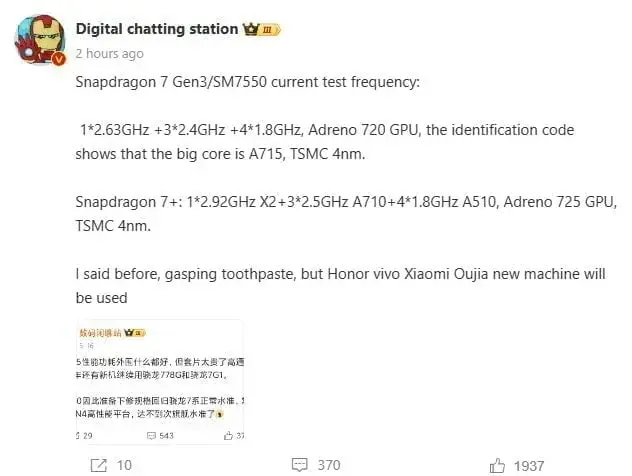What to Expect from the New Mid-Range Snapdragon 7 Gen3
Qualcomm is gearing up to launch its Snapdragon 7 Gen3 chip, which has been built on the TSMC 4nm process. However, leaked specifications suggest that this new chip might not outperform its predecessor, the Snapdragon 7+ Gen2.
Specifications Comparison
The Snapdragon 7 Gen3 features a 1+3+4 architecture, similar to its predecessor. Its CPU consists of 1×2.63GHz big core, 3×2.4GHz, and 4×1.8GHz cores, all powered by an Arm Cortex-A715 with an integrated Adreno 720 GPU.
On the other hand, the Snapdragon 7+ Gen2 boasts a CPU with 1×2.91GHz big core, 3×2.49GHz, and 4×1.8GHz cores, along with an integrated Adreno 725 GPU. It is evident that the Snapdragon 7 Gen3's specifications are slightly downgraded in terms of performance compared to the Snapdragon 7+ Gen2.
Strategic Decision for Efficiency and Cost-Effectiveness
The Snapdragon 7+ Gen2 has only been adopted in a few models, such as the Redmi Note 12 Turbo and the Realme GT Neo5 SE, primarily due to its higher cost. As a result, not many consumers have experienced its capabilities.
Qualcomm seems to have made a strategic decision with the Snapdragon 7 Gen3 to focus on efficiency and cost-effectiveness. This chip is positioned as a mid-range processor, rather than a sub-flagship model, making it a more accessible choice for smartphone manufacturers.
The Advantage of the TSMC 4nm Process
Despite its seemingly lower specifications, the Snapdragon 7 Gen3 has the advantage of being built on the advanced TSMC 4nm process. This is expected to result in improved energy efficiency and overall performance, even if it doesn't match the raw power of the Snapdragon 7+ Gen2.
Widening Market Reach
Manufacturers like Xiaomi, vivo, and others in Europe are expected to adopt the Snapdragon 7 Gen3 in their upcoming devices. With its cost-effective approach, this processor could find a broader market reach, making it a pivotal component in the next generation of smartphones.
Conclusion
In conclusion, while the Snapdragon 7 Gen3 may not surpass its predecessor in terms of performance, it is set to deliver a well-balanced blend of efficiency and cost-effectiveness. It will be interesting to see how it fares against the competition and whether it becomes the chip of choice for mid-range smartphones in the coming year.


Leave a Reply